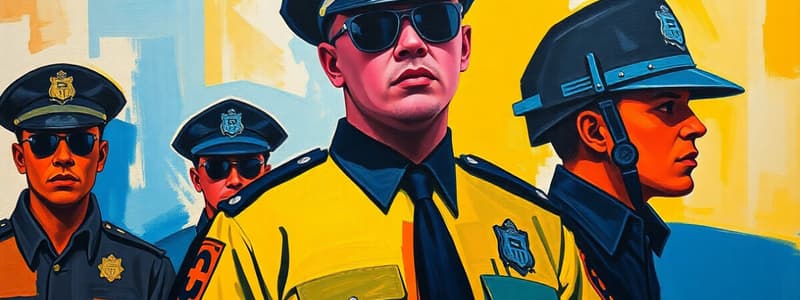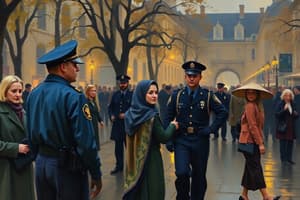Podcast
Questions and Answers
What does the confidence graph between white and black adults from 1993 to 2021 indicate?
What does the confidence graph between white and black adults from 1993 to 2021 indicate?
- The confidence levels are identical for both white and black adults.
- Black adults consistently have more confidence in police than white adults.
- White adults consistently held more confidence in police than black adults. (correct)
- Confidence among black adults has increased significantly over the years.
What problem arises from media coverage of police misconduct?
What problem arises from media coverage of police misconduct?
- It enhances community trust in police by focusing on isolated incidents.
- It accurately represents the majority of police officers' behaviors.
- It may lead to a belief that all police officers are misconduct-prone. (correct)
- It eliminates concerns about isolated incidents of police misconduct.
What is a common misconception about crime in inner cities mentioned in the discussion?
What is a common misconception about crime in inner cities mentioned in the discussion?
- Most people in inner cities are criminals.
- Crime is only an issue in suburban areas.
- The majority of residents in crime-ridden neighborhoods commit crimes.
- Only a small percentage of people in inner cities actually commit crime. (correct)
What is the risk associated with believing that all police engage in misconduct?
What is the risk associated with believing that all police engage in misconduct?
How does the speaker describe isolated cases of police misconduct?
How does the speaker describe isolated cases of police misconduct?
What is the primary difference between proactive and reactive policing?
What is the primary difference between proactive and reactive policing?
Why might proactive policing lead to community issues?
Why might proactive policing lead to community issues?
What is a consequence of police taking proactive actions without community consent?
What is a consequence of police taking proactive actions without community consent?
What is the function of non-emergency call services such as 311?
What is the function of non-emergency call services such as 311?
Which of the following statements about policing roles is accurate?
Which of the following statements about policing roles is accurate?
What is the main issue surrounding Officer Pinheiro's actions as depicted in the body camera footage?
What is the main issue surrounding Officer Pinheiro's actions as depicted in the body camera footage?
What consequence did Officer Pinheiro face as a result of the discovered footage?
What consequence did Officer Pinheiro face as a result of the discovered footage?
What does the pre-event record feature on body cameras ensure?
What does the pre-event record feature on body cameras ensure?
How did Officer Pinheiro's colleagues react during the incident captured on camera?
How did Officer Pinheiro's colleagues react during the incident captured on camera?
Which of the following best describes the situation that led to the case being dropped?
Which of the following best describes the situation that led to the case being dropped?
What aspect of police training is highlighted in the discussion regarding Officer Pinheiro's actions?
What aspect of police training is highlighted in the discussion regarding Officer Pinheiro's actions?
What was the result of the review of all 123 cases involving Officer Pinheiro?
What was the result of the review of all 123 cases involving Officer Pinheiro?
What is one significant consequence of police officers engaging in misconduct?
What is one significant consequence of police officers engaging in misconduct?
What percentage of a police officer's time is estimated to be spent on crime-related issues?
What percentage of a police officer's time is estimated to be spent on crime-related issues?
What does the commissioner imply about the perception of police officers by the community?
What does the commissioner imply about the perception of police officers by the community?
What describes the conventional wisdom regarding the role of police?
What describes the conventional wisdom regarding the role of police?
How do media representations influence public perception of police?
How do media representations influence public perception of police?
What does the commissioner identify as a basic expectation of police behavior?
What does the commissioner identify as a basic expectation of police behavior?
What aspect of police work do children and many in society often overlook?
What aspect of police work do children and many in society often overlook?
What is a likely reason for an individual's disbelief in police misconduct?
What is a likely reason for an individual's disbelief in police misconduct?
Why might the community assume police misconduct is a widespread issue?
Why might the community assume police misconduct is a widespread issue?
What is an implication of police officers behaving in a manner contrary to community expectations?
What is an implication of police officers behaving in a manner contrary to community expectations?
Flashcards are hidden until you start studying
Study Notes
Public Confidence in Police
- From 1993 to 2021, white adults consistently reported higher confidence in police than black adults, sometimes to the tune of twice as much.
- This disparity in confidence has been present since the start of the study period, indicating a systemic issue.
- The media plays a significant role in shaping public perception of policing, with potential to further divide communities and law enforcement.
The Impact of Isolated Cases of Police Misconduct
- Isolated cases of police misconduct can be extremely important and concerning, but they should not be misinterpreted to suggest that all or most police engage in similar behaviors.
- An overemphasis on negative incidents risks creating a perception that most police officers behave in harmful ways, which is not supported by evidence.
- This misrepresentation can lead to unfair judgements about the police profession as a whole.
The Importance of Police Training
- The length of police training (6-12 months) may not equip officers with all the tools they need to handle complex situations effectively.
- There is a need for ongoing development and support to address the multifaceted challenges that police face.
Evidence Planting Case in Baltimore
- Officer Pinheiro's body camera footage revealed him planting evidence, leading to the dismissal of 123 cases he was involved in.
- This incident demonstrated the critical role of technology in holding officers accountable for their actions.
- The video also revealed that other officers present seemingly condoned or even found amusement in the misconduct.
- The Baltimore police commissioner at the time acknowledged the seriousness of the incident, highlighting its negative impact on public trust.
The Reality of Police Work
- Conventional wisdom often portrays police as crime fighters, but studies show that they spend a relatively small portion of their time dealing with crime.
- Police officers perform a diverse range of duties beyond crime-fighting, serving as community members, problem solvers, and first responders.
Reactive vs Proactive Policing
- Reactive policing occurs when officers respond to citizen requests for service.
- Proactive policing involves officers initiating actions to address potential issues, such as setting up task forces for specific areas with high crime rates.
- Striking a balance between proactive and reactive policing is essential to maintain community trust and prevent over-intrusion.
The Role of Non-Emergency Call Services
- Cities have implemented non-emergency call services (311) to assist citizens with non-urgent issues and reduce the workload for emergency services.
- This allows police to prioritize their resources towards more serious issues, mitigating unnecessary strain on the system.
Mental Health and Well-being of Police Officers
- Studies indicate that police officers are more likely to take their own lives than to be killed in the line of duty.
- This alarming trend highlights the significant challenges faced by police officers in terms of mental health and trauma exposure.
- It is crucial for law enforcement agencies and society as a whole to prioritize mental health support and resilience training for officers.
Changing Narrative About Policing
- The perception of policing is evolving, driven by increasing awareness of the complexities of the profession and public demand for accountability.
- It is essential to continue promoting a more realistic understanding of police work, including its challenges, and to ensure officers receive adequate support for their mental health and well-being.
Studying That Suits You
Use AI to generate personalized quizzes and flashcards to suit your learning preferences.




